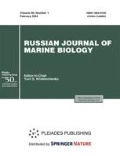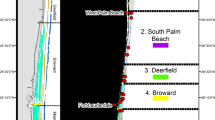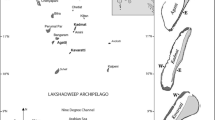Abstract
The distribution and size-age structure of Acropora corals were studied in two Maldivian atolls that differ in their geographic position and sea surface temperature regimes. The frequency and strength of thermal anomalies for the last 2 decades had a significant influence on the abundance, mortality rates, and age structures of acroporid communities. The long-term temperature amplitude was higher and the maxima were more pronounced in the northernmost Ihavandippolu Atoll than those in the equatorial South Huvadhoo Atoll. These differences resulted in a 10.4% mean cover of Acropora at Ihavandippolu Atoll, whereas the Acropora cover in the South Huvadhoo Atoll reached 59.5%. In the northern atoll, the coral mortality rate after the 2010 thermal anomaly was 3 times higher than that in the southern atoll. Younger acroporid colonies (up to 2 years old) dominated the northern atoll reefs, while the southern atoll showed a high proportion of older mature colonies. In both atolls, healthy table colonies of Acropora cytherea with a disk diameter greater than 2 m were observed that apparently survived three thermal anomalies since 1998. The mechanisms of acclimatization of Acropora and the prospects for its dominance in the Maldives under changing environmental conditions are discussed.
Similar content being viewed by others
References
Ali Khan, T.M., Quadir, D.A., and Hossain, M.A., An integrated approach to sea level changes, coastal erosion and inundation and their impacts on the coastal zone of Maldives, in SMRC Reports, Dhaka: SAARC Meteorol. Res. Center, no. 8, 2002. http://www.saarcsmrc.org
Baird, A.H., Bhagooli, R., Ralph, P.J., and Takahashi, S., Coral bleaching: the role of the host, Trends Ecol. Evol., 2009, vol. 24, pp. 16–20.
Bak, R.P.M. and Engel, M.S., Distribution, abundance and survival of juvenile hermatypic corals (Scleractinia) and the importance of life-history strategies in the parent coral community, Mar. Biol., 1979, vol. 54, pp. 341–352.
Baker, A.C., Starger, C.J., McClanahan, T.R., and Glynn, P.W., Corals’ adaptive response to climate change, Nature, 2004, vol. 430, pp. 741.
Bianchi, C.N., Mori, C., Pichon, M., et al., Dynamics and pattern of coral recolonization following the 1998 bleaching event in the reef of the Maldives, Proc. 10th ICRS, 2006, pp. 30–37.
Brown, B.E. and Dunne, R.P., The impact of coral mining on coral reefs in the Maldives, Environ. Conserv., 1988, vol. 15, pp. 159–165.
Burt, J., Al-Harthi, S., and Al-Cibahy, A., Long-term impacts of coral bleaching events on the world’s warmest reefs, Mar. Environ. Res., 2011, vol. 72, pp. 225–229.
Central Intelligence Agency (CIA) report on Maldives, 2012. https://www.cia.gov/library/publications/the-world-factbook/geos/mv.html
Ciarapica, G. and Passeri, L., An overview of the Maldivian coral reefs in Felidu and North Malé Atoll (Indian Ocean): platform drowning by ecological crisis, Facies, 1993, vol. 28, pp. 33–66.
Ciarapica, G. and Passeri, L., Coral bleaching in the Maldives (Ari Atoll), Reef Encounter, 1999, vol. 26, pp. 19–21.
Coleman, N., Marine Life of the Maldives, Victoria, Australia: Atoll Editions Publ., 2000.
Done, T.J., Coral community adaptability to environmental change at the scales of regions, reefs and reef zones, Am. Zool., 1999, vol. 39, pp. 66–79.
Edwards, A.J., Clark, S., Zahir, H., et al., Coral bleaching and mortality on artificial and natural reefs in Maldives in 1998, sea surface temperature anomalies and initial recovery, Mar. Pollut. Bull., 2001, vol. 42, pp. 7–15.
Glynn, P.W., Coral reef bleaching in the 1980s and possible connections with global warming, Trends Ecol. Evol., 1991, vol. 6, pp. 175–178.
Goreau, T.J. and Hayes, R.L., Coral bleaching and ocean “hot spot”, Ambio, 1994, vol. 23, pp. 176–180.
Guest, J.R., Baird, A.H., Maynard, J.A., et al., Contrasting patterns of coral bleaching susceptibility in 2010 suggest an adaptive response to thermal stress, PLoS One, 2012, vol. 7, no. 3, pp. 1–8.
Harriott, V.J., Coral growth in subtropical eastern Australia, Coral Reefs, 1999, vol. 8, pp. 281–291.
Kohler, K.E. and Gill, S.M., Coral Point Count with Excel extension (CPCe): a visual basic program for determination of coral and substrate coverage using random point count methodology, Comput. Geosci., 2006, vol. 32, pp. 1259–1269.
Kumar, T.T.A. and Balasubramanian, T., Bleaching of corals in Agatti-Lakshadweep, India: a window view, Proc. 12th Int. Coral Reef Symp., 2012. http://www.icrs2012.com/Proceedings.htm
Loch, K., Loch, W., Schuhmacher, H., and See, W.R., Coral recruitment and regeneration on a Maldivian reef 21 months after the coral bleaching event of 1998, Mar. Ecol.: Progr. Ser., 2002, vol. 23, pp. 219–236.
Marshall, P.A. and Baird, A.H., Bleaching of corals on the Great Barrier Reef: differential susceptibility among taxa, Coral Reefs, 2000, vol. 19, pp. 155–163.
McClanahan, T.R., Bleaching damage and recovery potential of Maldivian coral reefs, Mar. Pollut. Bull., 2000, vol. 40, pp. 587–597.
McClanahan, T.R., The relationship between bleaching and mortality of common corals, Mar. Biol., 2004, vol. 144, pp. 1239–1245.
Miller, M.W., Bourque, A.S., and Bohnsack, J.A., An analysis of the loss of acroporid corals at Looe Key, Florida, USA: 1983–2000, Coral Reefs, 2002, vol. 21, pp. 179–182.
Phongsuwan, N. and Chansang, H., Repeated coral bleaching in the Andaman Sea, Thailand, during the last two decades, Res. Bull. Phuket Mar. Biol. Center, 2012, vol. 71, pp. 19–41.
Pillai, C.S.G. and Scheer, G., Report on the stony corals from the Maldivian Archipelago, Zoologica, 1976, vol. 126, pp. 1–83.
Rayner, N.A., Parker, D.E., Horton, E.B., et al., Global analysis of sea surface temperature, sea ice, and night marine air temperature since the late nineteenth century, J. Geophys. Res., 2003, vol. 108, no. D14, p. 4407.
Rowan, R., Thermal adaptation in reef coral symbionts, Nature, 2004, vol. 430, p. 742.
Sheppard, C.R.C., The reef and soft substrate coral fauna of Chagos, Indian Ocean, J. Nat. Hist., 1981, vol. 15, pp. 607–621.
Stimpson, J., The effect of shading by the table coral Acropora hyacinthus on understory corals, Ecology, 1985, vol. 66, pp. 40–53.
Tamelander, J. and Rajasuriya, A., Status of coral reefs in South Asia: Bangladesh, Chagos, India, Maldives and Sri Lanka, Status of coral reefs of the world: 2008, Townsville: Aust. Inst. Mar. Sci., 2008, pp. 119–130.
Tkachenko, K.S., The northernmost coral frontier of the Maldives: the coral reefs of the Ihavandippolu Atoll under long-term environmental change, Mar. Environ. Res., 2012, vol. 82, pp. 40–48.
West, J.M. and Salm, R.V., Resistance and resilience to coral bleaching: implications for coral reef conservation and management, Conserv. Biol., 2003, vol. 17, pp. 956–967.
Wilkinson, C., The 1997–1998 Mass Bleaching Event Around the World, Status of Coral Reefs of the World: 1998, Townsville: Aust. Inst. Mar. Sci., 1998, pp. 15–38.
Wilkinson, C., The 1997–1998 Mass Bleaching Event Around the World, 2: Years on, Townswille: Aust. Inst. Mar. Sci., 2000, pp. 21–34.
Zahir, H., Status of the coral reefs of Maldives, Coral Reef Degradation in the Indian Ocean (CORDIO): Status Reports, 2002, pp. 119–124.
Zahir, H., Quinn, N., and Cargillia, N., Assessment of Maldivian Coral Reefs in 2009 after Natural Disasters, Male, Republic of Maldives: Marine Research Centre, 2010.
ReefBase-A Global Information System on Coral Reefs. http://www.reefbase.org
IUCN Red List of Threatened Species, v. 2012.2. http://www.iucnredlist.org
Met Office HadISST 1.1 (Global sea-Ice coverage and Sea Surface Temperature) (1870-Present) Dataset, Centre for Environmental Data Archival, Science and Technology Facility Council. http://badc.nerc.ac.uk/data/hadisst/
Coral Reef Watch Satellite Monitoring, NOAA Satellite and Information Service. http://coralreefwatch.noaa.gov
Author information
Authors and Affiliations
Corresponding author
Additional information
Original Russian Text © K.S. Tkachenko, 2014, published in Biologiya Morya.
Rights and permissions
About this article
Cite this article
Tkachenko, K.S. The influence of repetitive thermal stresses on the dominance of reef-building Acropora spp. (Scleractinia) on coral reefs of the Maldive Islands. Russ J Mar Biol 40, 286–294 (2014). https://doi.org/10.1134/S1063074014040105
Received:
Published:
Issue Date:
DOI: https://doi.org/10.1134/S1063074014040105




